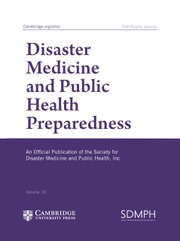No CrossRef data available.
Article contents
Analysis of Disparities in the Initial Health Care Response to the February 2023 Earthquakes in Turkey and Syria
Published online by Cambridge University Press: 18 November 2024
Abstract
This study analyzes disparities in initial health care responses in Turkey and Syria following the 2023 earthquakes.
Using Humanitarian Data Exchange, Crude Mortality Rates (CMR) and injury rates in both countries were calculated, and temporal trends of death tolls and injuries in the first month post- catastrophe were compared. World Health Organization (WHO) Flash Appeal estimated funding requirements, and ratios of humanitarian aid personnel in Urban Search and Rescue (USAR) teams per population from ReliefWeb and MAPACTION data were used to gauge disparities.
56 051 096 individuals were exposed, with Turkey having 44 million vs 12 million in Syria. Turkey had higher CMR in affected areas (10.5 vs. 5.0 per 10,000), while Syria had higher CMR in intensely seismic regions (9.3 vs. 7.7 per 1,000). Turkey had higher injury rates (24.6 vs. 9.9 per 10 000). Death and injury rates plateaued in Syria after 3 days, but steadily rose in Turkey. Syria allocated more funding for all priorities per population except health care facilities’ rehabilitation. Turkey had 219 USAR teams compared to Syria’s 6, with significantly more humanitarian aid personnel (23 vs. 2/100,000).
Significant disparities in the initial health care response were observed between Turkey and Syria, highlighting the need for policymakers to enhance response capabilities in conflict-affected events to reduce the impact on affected populations.
The 2023 Turkish-Syrian earthquakes, the most devastating in the region since 1939, heightened challenges in Syria’s health care system amid ongoing conflict, disrupting Gaziantep’s humanitarian aid supply route. The initial health care responses post-earthquakes in Turkey and Syria were analyzed through a descriptive study, where Crude Mortality Rates (CMR) and injury rates during the first week were calculated. The World Health Organization’s funding priorities and the ratio of humanitarian aid personnel in Urban Search and Rescue teams per population were assessed. Turkey had 4-fold higher earthquake exposure and experienced higher CMR and injuries per population, while Syria had higher CMR in intensely seismic regions. Temporal trends showed plateaued death and injury rates in Syria within 3 days, while Turkey’s continued to increase. Syria required more funding across nearly all priorities while Turkey had more humanitarian aid personnel per population. Significant health care response disparities were observed, emphasizing the imperative for policymakers to enhance initial responses in conflict-affected events.
Keywords
- Type
- Review Article
- Information
- Copyright
- © The Author(s), 2024. Published by Cambridge University Press on behalf of Society for Disaster Medicine and Public Health, Inc


